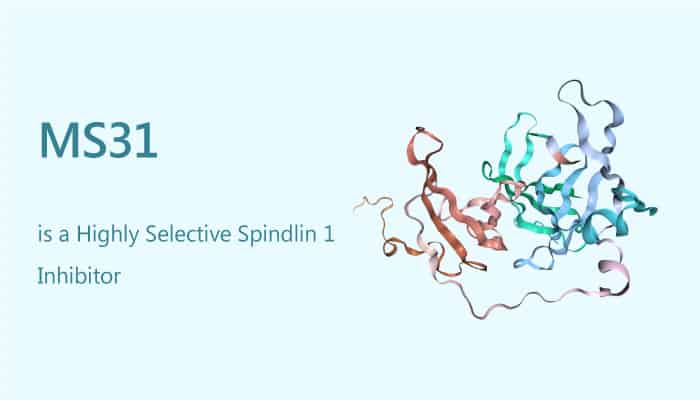SPIN1 (Spindlin 1) is a chromatin reader protein. It recognizes trimethylated histone H3 lysine 4 (H3K4me3) through the protein-protein interaction at the defined “aromatic cage” in Tudor domain II. The interaction between asymmetrically dimethylated histone H3 arginine 8 (H3R8me2a) and Tudor domain I further increases the affinity. On the other hand, several types of malignant tumors overexpress SPIN1. Upregulation of SPIN1 increases cellular proliferation, abnormal mitosis and chromosomal instability. In addition, SPIN1 is involved in several signaling pathways, such as Wnt/TCF-4 and RET signaling pathways. Therefore, small molecules that selectively disrupt the protein-protein interactions between SPIN1 and its respective binding partners are valuable chemical tools. MS31 is a potent, highly affinity, and selective fragment-like methyllysine reader protein spindlin 1 inhibitor. It potently and selectively disrupted the protein–protein interactions between SPIN1 and H3K4me3.

MS31 potently inhibits the interactions between SPIN1 and H3K4me3 (IC50=77 nM (AlphaLISA) and 243 nM (FP)). It selectively binds Tudor domain II of SPIN1 (Kd=91 nM). In addition, MS31 do not significantly inhibit the enzymatic activity of 33 methyltransferases and 5 acetyltransferases at 10 µM (blue) and 50 µM. It do not induce significant thermal shifts for 20 methyllysine, methylarginine and acetyllysine reader proteins at 20 µM or 200 µM in thermal shift assays. Moreover, MS31 is not toxic to C2C12 and 293T cell lines or primary fibroblasts HFF1, at up to 30 µM. MS31 disrupts the interaction between SPIN1 and histone H3 (IC50=3.2 ± 0.7 µM) in U2OS cells.
In summary, MS31 is a potent, cell permeable, highly selective and fragment-like methyllysine reader protein spindlin 1 inhibitor. Furthermore, it is nontoxic to nontumorigenic cells. Thus, it paves the way for discovering improved inhibitors of methyllysine reader proteins.
Reference:
Xiong Y, et al. J Med Chem. 2019 Jul 24.